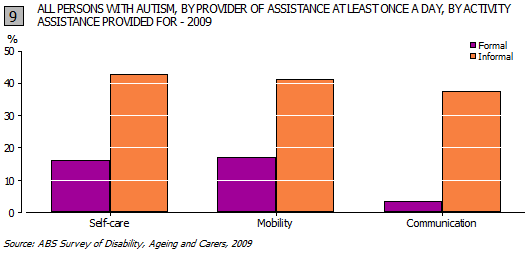 RECEIPT OF ASSISTANCE
RECEIPT OF ASSISTANCE
The question arises whether people with autism were receiving as much assistance as they needed. In 2009, many people with autism did not. The need for more assistance in the core activities of mobility, communication and self-care are particularly noteworthy (see Graph 8).

This means there were 15,400 people with autism needing more help with communication (understanding or being understood by others) and 22,600 needing more help with cognitive or emotional tasks (managing their emotions and/or behaviour).
The bulk of care was provided by informal carers (relatives or friends), particularly in the core activity areas of self-care, mobility and communication. Graph 9 shows the proportion of people with autism who received assistance with an activity at least once a day by the source of the receipt of that assistance. Formal care providers provided less than one third of the care with these core activities. In the case of communication, formal care providers provided less than 10% of the care received on a daily basis with 2,200 people receiving daily assistance from formal care providers.

 Print Page
Print Page
 Print All
Print All